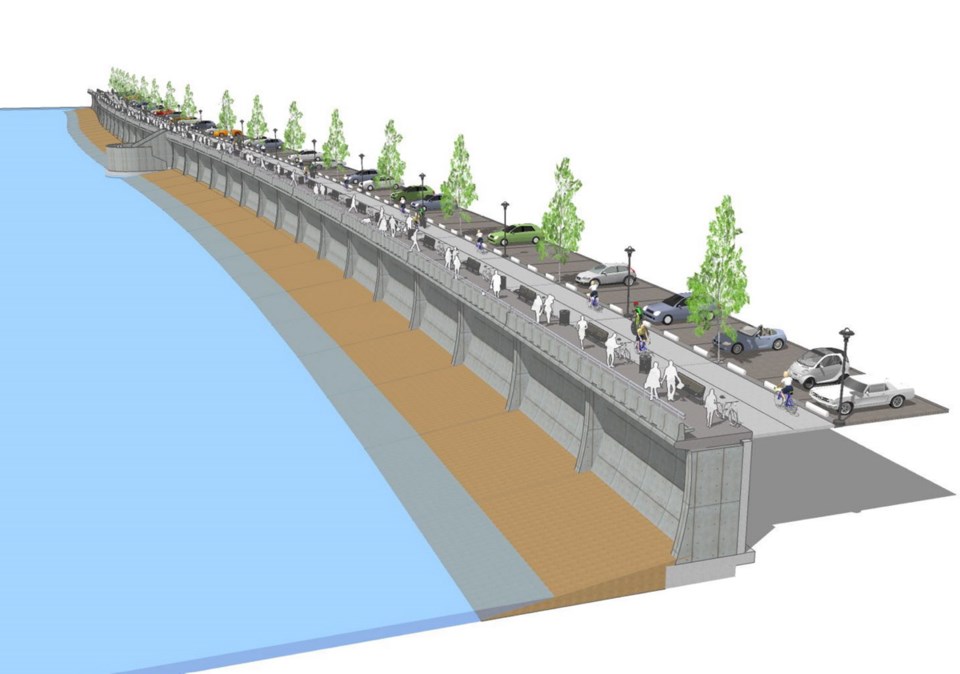A commentary by an architect and urban design planner from North Saanich.
The proposed Dallas Road ocean barriers do yet not quite reach for the potential at hand.
Good on the City of Victoria for taking on developing a waterfront bikeway system, as well as some of the needed refurbishing of the Dallas Road waterfront barriers between Ogden and Holland Points, and good on colleague Doug Lee for identifying vulnerabilities of a light aluminum frame guard to storm forces in this location. (“New Dallas Road railing won’t withstand storms, says retired architect,” June 5.)
But vulnerabilities within the existing ocean barrier system are more profound. In my role as an architect and urban design planner in Victoria, I had discussed with other city staff the need to add support to the aged large concrete retaining wall below, as well as opportunities to enhance conditions for the adjacent bike-way then being planned – and described the potential for an impressive civic waterfront esplanade in this location.
The existing high concrete seawall, exposed and weathered from about 70 years of wave assault, was showing areas of fracture, and of foundation undermining — becoming quite vulnerable to even moderate seismic events.
As well, the roadway was too narrow for all the dimensions needed for a wide sidewalk, retention of perpendicular parking, and planned bike lanes. A sturdy new concrete wall, cast in front of the old, could be designed to support that declining structure – with ample new concrete footings placed under the beach level, hidden.
Then, with intermittent buttresses, a new out-reaching concrete sidewalk structure could be cast above the wall, spanning between the buttresses. In addition to offering a generous-sized new walkway, this structurally integrated solution would allow for the planned bikeway, as well as retention of all of the valued areas of visitor parking — all facing prime views to the Olympic Mountains, and with space to include seating, and outlook and interpretive features suited to those prime prospects.
The potential is here, to highlight the location as an outstanding public oceanfront, linking from the Breakwater to Beacon Hill Park at Ogden Point.
Perhaps most importantly, a new construction could be designed comprehensively to look ahead to cope with advancing sea-level rises, and awaiting earthquake impacts. Additionally, the new regional sewer trunk line, several metres north of the seawall, would have a wisely protective seawall barrier.
The assembly of a heavy new concrete wall and buttresses, topped with a walkway tier, could also be designed to create a wave deflector, to help keep a large portion of storm debris from being cast onto the road – somewhat like the seawall at Ross Bay.
After reading Lee’s letter, I walked the current project. Much of the old wall has been surfaced with a concrete facing that appears to be about 10-15 cm thick, while some selective areas of low support buttresses have been placed at the base of vulnerable areas of the old wall — improvements to be sure, and all improvements are commendable.
Obviously full construction of a sturdy new wall with large footings, placed against the original, and supporting a walkway, and with a wave deflecting face — would have an expense several times beyond what is now under construction. Input from the province and federal agencies would be entailed for a project projecting under and above the beachfront.
But following the pending battery of sea-level rise and of seismic events, how would these budget levels and team involvements compare with the costs and environmental challenges of clearing off sections of a large broken concrete wall from the beach, and starting from scratch for a new barrier system?
Planning a broad, dramatic ocean “Malecon” esplanade for Victoria, from the park to the breakwater, could in time be a legacy for generations to come. Augmenting or adding to the current project remains a possibility, albeit in future years.
But a project, more ambitious than the current, could offer just the type of grand, carefully implemented, civil works project — which could contribute an up-lift from our current times of pandemic despondency, and help create productive employment for an economically and spiritually recovering civic future.



